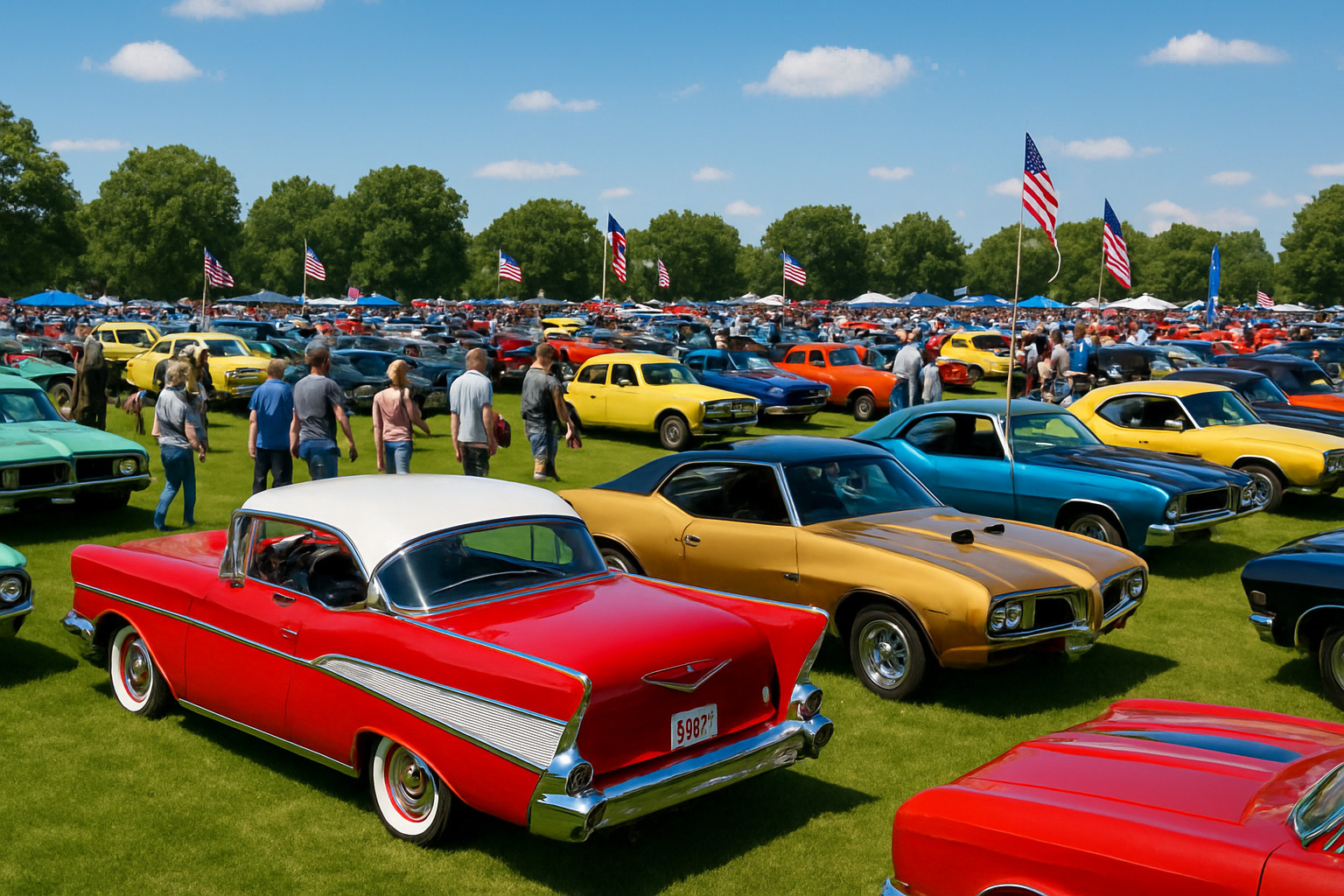Car culture events: 10 Ultimate Best in 2025 Revealed
Revving Up: The World of Car Culture Events
There’s something magical about the rumble of engines and the gleam of polished chrome under the summer sun. Car culture events bring this magic to life, creating spaces where automotive passions flourish and communities connect over their shared love of everything on wheels.
These gatherings have become the heartbeat of automotive enthusiasm worldwide, from sprawling international expositions to intimate local meetups where stories are shared over open hoods. They’re where memories are made, friendships are formed, and sometimes, dreams of that perfect ride come true.
The landscape of car culture events is wonderfully diverse. You’ll find formal car shows where judges scrutinize every detail of carefully restored classics. Cruise-ins offer a more relaxed vibe, with owners casually displaying their pride and joy at local parking lots or coffee shops. Multi-day festivals combine cruises, competitions, and entertainment, while track events satisfy the need for speed and performance. And don’t forget swap meets – treasure hunts where enthusiasts search for that elusive part or vintage memorabilia.
“You literally couldn’t find a better backdrop for a bunch of old cars and the people that admire them,” as one event organizer beautifully put it.
What began decades ago as small fundraisers or neighborhood gatherings has evolved into cultural phenomena. Take the Woodward Dream Cruise – born in 1995 as a modest charity event, it now floods Detroit’s famous boulevard with over 40,000 classic cars and a million spectators annually. This evolution speaks to our enduring connection with automobiles as more than transportation – they’re rolling time capsules of design, innovation, and personal history.
Beyond the vehicles themselves, these events create vibrant communities. Whether your heart races for American muscle cars, import tuners, air-cooled Porsches, or cutting-edge electric restomods, there’s a gathering custom to your automotive tastes. Many events accept family-friendly activities, live music, and cultural elements that extend the experience beyond the parking lot.

The global car culture events scene continues to grow, with gatherings on every continent celebrating both universal automotive passion and unique regional flavors. From Tokyo’s rockabilly-infused MOONEYES Street Car Nationals to Florida’s prestigious Amelia Concours d’Elegance, these events have become destinations in themselves – places where the journey and the destination are equally meaningful.
So polish that paint, check your tire pressure, and mark your calendar. The world of car culture events awaits, and trust us – there’s nothing quite like being there in person, surrounded by kindred spirits who understand why a beautiful car can make your heart skip a beat.
Woodward Dream Cruise
The Woodward Dream Cruise isn’t just another car show – it’s automotive heaven on wheels. Imagine 40,000 gleaming classics, hot rods, and muscle cars parading down a historic 16-mile stretch of Detroit boulevard while over one million spectators cheer them on. This is Motor City’s ultimate block party!
What started in 1995 as a humble fundraiser for a local soccer field has roared into the world’s largest single-day automotive event. There’s something magical about seeing these magnificent machines cruising the very streets where American car culture was born.
“I’ve been coming since ’97, and there’s nothing like the rumble of those engines echoing down Woodward,” shares Mike, a Cruise regular. “It’s like stepping into a time machine where Detroit’s glory days never ended.”
The beauty of the Dream Cruise lies in its welcoming spirit. You’ll spot pristine museum-quality Corvettes alongside weekend project cars, all sharing the same asphalt. Families stake out prime viewing spots with coolers and lawn chairs, creating a festival atmosphere that celebrates both cars and community.
Car culture events like this one showcase Detroit’s automotive heritage while supporting local charities. The Dream Cruise has maintained its charitable roots even as it has grown exponentially. Local businesses along the route transform into mini-festival grounds with food vendors, merchandise tents, and special viewing areas.

The event perfectly captures American muscle car culture – those iconic machines from the ’60s and ’70s with their rumbling V8s and bold styling. But you’ll also find everything from pre-war classics to modern exotics. The only requirement? A passion for automobiles.
Unlike exclusive concours events, the Woodward Dream Cruise costs nothing to attend as a spectator. For participants, there’s no formal registration – just bring your ride and join the rolling parade. This accessibility is what makes it truly special – a celebration of cars that belongs to everyone.
If you’re planning to experience this automotive extravaganza, mark your calendar for the third Saturday in August. Just remember to arrive early, wear comfortable shoes, and bring your camera – you’ll want to capture every gleaming fender and chrome bumper of this uniquely American celebration.
Cruisin’ The Coast
If the Woodward Dream Cruise is Detroit’s automotive celebration, then Cruisin’ The Coast is definitely the South’s answer to it – with a beachy twist! Often called “America’s Largest Block Party,” this October gathering transforms Mississippi’s stunning Gulf Coast into a car lover’s paradise that stretches across 30 miles of scenic shoreline from Bay St. Louis to Ocean Springs.
What began as a modest gathering back in 1996 has blossomed into a week-long celebration featuring more than 7,000 registered vehicles. The growth has been phenomenal, drawing participants from across the country who make this an annual tradition.
“It’s like a massive seaside block party where the cars are always in motion,” explains one longtime participant. “You can spend the morning showing your ride in one town, cruise to another for lunch, and finish the day at a beachside concert—all while surrounded by incredible vehicles.”
Unlike static car shows, Cruisin’ The Coast accepts movement. Participants cruise between multiple venue sites in different coastal communities, with each town offering its own special blend of entertainment, food vendors, and mini-events. One moment you’re admiring cars in a beachfront parking lot, and the next you’re part of a rolling exhibition along the Gulf’s beautiful coastline.
The atmosphere is electric, with live bands performing throughout the week. The soundtrack typically features rock ‘n’ roll, rockabilly, and oldies that perfectly complement the classic car vibe. Many attendees even dress in period clothing, enhancing the nostalgic feel that permeates the event.
While classic American iron dominates the scene (think gleaming ’57 Chevys and rumbling muscle cars), the event welcomes all interesting vehicles. This diversity creates an automotive landscape that appeals to enthusiasts of every stripe.
For the local Gulf Coast communities, Cruisin’ The Coast delivers a massive economic boost during what would otherwise be a quieter shoulder season. Hotels fill to capacity, restaurants overflow with hungry car lovers, and local businesses thrive during this automotive celebration.
The event has become more than just a car show – it’s a cultural phenomenon that celebrates America’s love affair with automobiles against the beautiful backdrop of Mississippi’s coastline. The combination of stunning cars, ocean views, southern hospitality, and perfect fall weather makes this a bucket-list event for automotive enthusiasts nationwide.
Amelia Concours d’Elegance
For those who appreciate automotive elegance at its finest, The Amelia Concours d’Elegance represents the pinnacle of car culture events. Held annually at the Ritz-Carlton resort on Amelia Island, Florida, this prestigious gathering showcases the world’s most rare and valuable automobiles in a setting befitting their status.
Unlike the more casual cruise events, The Amelia (as it’s often called) is a highly curated exhibition where vehicles are selected based on historical significance, authenticity, and sheer beauty. These automotive masterpieces are displayed on the manicured golf course lawns, creating a museum-quality exhibition in an outdoor setting.
“The Amelia Concours bridges the gap between automotive history and fine art,” explains a regular judge. “These aren’t just cars—they’re rolling sculptures that represent the highest achievements in design, engineering, and craftsmanship from every era.”
The event features several distinct classes, from pre-war classics to modern supercars, with each vehicle judged by experts in their respective fields. Winning “Best in Show” at The Amelia is one of the highest honors in the collector car world.
Beyond the main concours, The Amelia includes high-end auctions where multi-million dollar vehicles change hands, seminars with industry legends, and exclusive gatherings. Despite its upscale nature, the event maintains a strong philanthropic mission, having raised over $4 million for local charities.

What truly distinguishes The Amelia is its thematic approach, with each year featuring special classes that tell automotive stories—whether celebrating a manufacturer’s anniversary, honoring racing legends, or showcasing designs that changed the industry. The judging process itself is a spectacle, with owners proudly standing beside their vehicles as experts examine every detail from historical accuracy to restoration quality.
The atmosphere at The Amelia blends casual Florida sunshine with sophisticated automotive appreciation. Attendees often dress smartly for the occasion, sipping champagne while discussing the finer points of a rare Ferrari or debating the historical significance of a pre-war Bugatti. It’s as much a social event as it is an automotive one, bringing together collectors, historians, designers, and enthusiasts in a shared celebration of automotive excellence.
While tickets aren’t inexpensive, the experience offers unparalleled access to vehicles that are often hidden away in private collections, making it a bucket-list event for serious car lovers who appreciate the artistic and historical significance of automotive design.
Grand National Roadster Show
If you’ve ever wanted to see the absolute pinnacle of hot rod craftsmanship, the Grand National Roadster Show (GNRS) is your automotive mecca. Housed within the sprawling Fairplex in Pomona, California, this isn’t just any car culture event – it’s the longest-running indoor car show on the planet, with roots stretching back to 1950.
The crown jewel of the GNRS is the competition for the “America’s Most Beautiful Roadster” trophy – a towering nine-foot award that instantly transforms its winner from builder to legend. This isn’t just hardware; it’s hot rod immortality.
“The AMBR trophy isn’t just about having the shiniest paint or the most expensive parts,” a veteran builder once told me with a knowing smile. “It’s about pushing the boundaries of what’s possible while still honoring the spirit of traditional hot rodding. Every detail matters, from the upholstery stitching to the engine bay layout.”
Walking through the Fairplex buildings feels like entering automotive heaven, with over 500 competition vehicles gleaming under the lights. Each one represents thousands of hours of craftsmanship, vision, and passion. Step outside, and you’ll find another 800 incredible machines participating in the “Grand Daddy Drive-In” portion of the show – a sea of chrome, custom paint, and rumbling engines.
What makes the GNRS truly special is how it bridges past and future. While deeply rooted in tradition, the show accepts evolution. Builders debut years-long projects here, often showing innovative techniques that push hot rodding forward while respecting its heritage. You’ll see everything from faithfully restored 1932 Ford roadsters to boundary-pushing customs that challenge what a car can be.
For those who prefer their hot rods with a bit more grit and a little less polish, the “Suede Palace” area celebrates the raw, grassroots spirit of early rodding. These vehicles wear their imperfections proudly, showcasing the authentic soul of custom car culture rather than trailer-queen perfection. The Palace has its own awards and dedicated following who appreciate this back-to-basics approach.
The GNRS isn’t just a show – it’s a living museum where automotive artistry and mechanical ingenuity come together in spectacular fashion. For anyone who appreciates the hot rod as America’s unique contribution to automotive culture, this Pomona pilgrimage is absolutely essential.
MSRA Back to the 50’s Weekend
Few events capture the nostalgic spirit of American car culture events quite like the MSRA Back to the 50’s Weekend. Held annually at the Minnesota State Fairgrounds in St. Paul, this massive gathering hosted by the Minnesota Street Rod Association (MSRA) transforms the 320-acre fairgrounds into a living museum of pre-1965 automobiles.
With over 10,000 registered vehicles, it’s one of the largest gatherings of classic cars in the world. The sheer scale is breathtaking—row after row of gleaming chrome, tail fins, and candy-colored paint jobs stretching as far as the eye can see.
“Back to the 50’s isn’t just a car show—it’s a time machine,” says a longtime participant. “From the moment you enter the gates, you’re transported to an era when cars had personality and style was everything. The sound of rumbling V8s and the smell of high-octane fuel create an atmosphere you can’t find anywhere else.”
Unlike concours events with their formal judging, Back to the 50’s accepts a more relaxed approach. There are no trophies or competitions—just the pure joy of sharing automotive passion with like-minded enthusiasts. This creates a friendly, inclusive atmosphere where a carefully restored Cadillac might park next to a primer-coated work in progress.

The weekend’s enormous swap meet is a treasure hunter’s paradise. Parts seekers wander through thousands of vendor spaces, searching for that elusive trim piece or the perfect set of vintage wheels. You’ll hear excited shouts when someone finally finds that needle-in-a-haystack part they’ve been seeking for years.
Families love this event because it offers something for everyone. The dedicated Kids Zone ensures the next generation of car lovers can develop their passion through age-appropriate activities. Meanwhile, parents and grandparents share stories about the cars of their youth, creating meaningful connections across generations.
The nostalgic atmosphere extends beyond just the vehicles. Rockabilly music fills the air, food vendors serve up classic American fare, and many attendees dress in period clothing. The overall effect is like stepping into a more colorful, chrome-plated era of American history.
Many participants choose to camp right on the fairgrounds, turning the weekend into a complete immersion experience. As evening falls, the rows of campers come alive with impromptu gatherings, storytelling sessions, and the occasional engine rev that echoes through the summer night.
Iola Car Show
Something magical happens each July in the tiny town of Iola, Wisconsin. This sleepy community of just 1,300 residents suddenly becomes the epicenter of Midwest car culture as more than 130,000 automotive enthusiasts pour in for the legendary Iola Car Show. The contrast is striking – a massive gathering of 2,500 show cars spread across 300+ acres of otherwise peaceful countryside.
Since its humble beginnings in 1972, this small-town show has blossomed into a three-day celebration that car lovers mark on their calendars months in advance. The event specializes in vehicles from the 1980s and earlier, offering visitors a comprehensive journey through automotive history.
“What makes Iola special is how it balances being enormous in scale while maintaining a hometown feel,” explains a regular attendee. “You can spend hours exploring thousands of show cars, then find yourself chatting with a vehicle owner who’s been coming here for decades and knows the history of every bolt on their restoration.”
The swap meet at Iola has achieved almost mythical status among parts hunters. With over 4,000 vendor spaces, it’s a treasure trove where restorers can unearth everything from obscure trim pieces to vintage shop manuals. Many enthusiasts plan restoration projects around their annual Iola pilgrimage, knowing this might be their only chance to find that elusive part they’ve been searching for.
Beyond the show field and swap meet, Iola features a busy “Car Corral” with around 400 vehicles available for purchase. This creates a unique marketplace where you might just find your next project car while surrounded by inspiration from the show field.
What truly sets Iola apart from more urban car culture events is its accept of its rural Wisconsin roots. The “Blue Ribbon” tractor corral showcases vintage farm equipment alongside automotive history, acknowledging the agricultural heritage that shaped the region. This authentic connection to the land gives Iola a distinct character you won’t find at city-based shows.
The community aspect of Iola extends well beyond daylight hours. Extensive on-site camping options transform the event into a multi-day immersion in car culture. Evening gatherings around campfires, impromptu parking lot meetups, and shared meals create lasting friendships among attendees who return year after year, creating their own traditions within the larger event.
For families, Iola offers a perfect introduction to car culture events with its relaxed atmosphere and wide-open spaces. Children can experience the excitement of automotive history coming alive, while parents appreciate the family-friendly environment and reasonable entry fees compared to larger urban shows.
Whether you’re hunting for rare parts, showcasing your pride and joy, or simply soaking in the atmosphere of automotive passion, the Iola Car Show delivers a quintessentially Midwestern car experience – big in scale but warm in heart.
Eastern Division AACA Fall Meet
Affectionately known simply as “Hershey” among enthusiasts, the Eastern Division AACA National Fall Meet transforms the town of Hershey, Pennsylvania into the epicenter of antique automobile culture every October. Since 1955, this four-day extravaganza has been where the past and present of automotive history converge in spectacular fashion.
What truly sets Hershey apart is its unwavering dedication to authenticity. Unlike hot rod shows or custom car events, the AACA celebration places historical accuracy on a pedestal. When you walk the judging lanes, you’re not seeing modified classics – you’re witnessing carefully preserved time machines restored to exactly how they appeared when they first rolled off assembly lines decades ago.
“The first time I attended Hershey, I was overwhelmed by seeing vehicles I’d only read about in books,” shares a longtime participant. “From brass-era beauties to post-war classics, each one tells a story about its era through every correct bolt and authentic finish.”
The heart of the Hershey experience might well be its legendary flea market – a sprawling automotive archaeology site covering over 9,000 vendor spaces. Early mornings see dedicated hunters armed with flashlights scouring tables before dawn, searching for that elusive trim piece or impossible-to-find manual. The excitement of finding a rare part that completes a years-long restoration project creates an atmosphere of shared triumph among attendees.
Car culture events like Hershey foster unique communities. You’ll find multi-generational families working together, with grandparents passing down knowledge about distinguishing authentic parts from reproductions to younger enthusiasts. The show fields showcase everything from humble Model Ts to rare European luxury cars, all judged with the same exacting standards.
The car corral area serves as an open-air marketplace where hundreds of antique vehicles change hands. Unlike typical used car lots, these transactions often happen between people who share deep knowledge and passion for specific makes and models. Many significant collections trace their beginnings to a fortuitous Hershey purchase.
Beyond the vehicles themselves, Hershey offers educational seminars, technical demonstrations, and opportunities to meet authors and historians specializing in automotive heritage. For many attendees, the fall pilgrimage to this chocolate-scented town has become a cherished annual tradition spanning decades.
The weather at Hershey has become legendary in its own right – from perfect fall days with colorful foliage to notorious downpours that transform the fields into muddy challenges. Veterans come prepared for anything, with stories of “the year it snowed” or “the great flood” becoming part of the event’s rich folklore.
For anyone serious about automotive history, experiencing Hershey at least once is considered essential – not just to find parts or display a vehicle, but to become part of the living heritage that keeps our automotive past alive and accessible for future generations.
Clean Culture Nationwide Series
If you’re looking for where the modern automotive scene thrives, Clean Culture events are where you’ll find the beating heart of contemporary car culture. Born in New York in 2014, this dynamic series has exploded across America, now hosting vibrant gatherings in more than 25 states and expanding internationally to three countries.
Unlike the chrome-heavy classic shows, Clean Culture accepts the cutting edge. These events are a playground for import tuners, European luxury builds, and modified domestics where stance culture, performance upgrades, and fresh styling approaches take center stage. The atmosphere crackles with energy as the sun sets and custom lighting transforms ordinary vehicles into works of art.
“Clean Culture has redefined what a car show can be for the next generation,” shares one regular participant. “It’s high-energy, visually stunning, and perfectly aligned with how younger enthusiasts experience car culture through platforms like Instagram and TikTok.”
What makes these gatherings special is their unique vibe—often described as having “the quality of a show, vibe of a meet.” This sweet-spot balance creates something more structured than random parking lot meetups but less formal than traditional judged events. Many Clean Culture shows happen at dusk or after dark, when dramatic lighting makes modified vehicles truly pop.
The tech-savvy organizers have revolutionized the often tedious registration process with their express system that gets you signed up in 60 seconds or less. This digital-first approach resonates perfectly with their smartphone-native audience.
From the massive concrete expanses of Dodger Stadium and MetLife Stadium to the storied asphalt of Daytona and Road Atlanta, Clean Culture selects venues that provide epic backdrops for the hundreds—sometimes thousands—of vehicles that attend each event. The growth has been phenomenal, reflecting just how powerfully modified car culture connects with millennials and Gen Z enthusiasts.
Ready to experience the energy yourself? You can grab tickets here for upcoming events. The Clean Culture series offers a perfect entry point for newcomers to car culture events, with its welcoming community and Instagram-worthy visual feast making it easy to dive into the scene.
Luftgekühlt
There’s something magical that happens when you combine air-cooled Porsches with unexpected industrial spaces. That’s the essence of Luftgekühlt (German for “air-cooled”), perhaps the most artfully curated automotive gathering you’ll ever experience.
Founded by Porsche factory racing driver Patrick Long and creative director Howie Idelson, Luftgekühlt isn’t your typical cars-in-a-parking-lot affair. These events transform architecturally significant venues—think lumber yards, warehouses, and most recently the historic Mare Island Naval Shipyard in Vallejo, California—into temporary galleries where Porsches become art installations.
“I drove three hours just to experience this,” one attendee told me, gesturing toward a pristine 356 Speedster positioned against weathered machinery. “Where else can you see these cars presented like this? It’s not a show, it’s an experience.”
The ninth edition at Mare Island was their largest gathering yet. The official recap captured it perfectly: “Air-cooled Porsches of all models, shapes, and colors were the feature; framed in pallets, and positioned next to retired cranes, ships, and rusted structures.”

What truly sets Luftgekühlt apart is its thoughtful curation. Vehicles aren’t randomly parked—they’re strategically positioned to create visual stories and unexpected contrasts. You might find a multi-million dollar racing prototype beside a lovingly maintained daily driver, challenging how we value these machines.
The organizers have a keen eye for these juxtapositions. A sun-faded, original-condition 911 might be deliberately placed next to a carefully restored example of the same year, creating a conversation between preservation and restoration that goes beyond what typical car shows achieve.
This artistic approach has cultivated a devoted following. Limited tickets often sell out within hours of release, creating an exclusivity that improves the event’s appeal. People travel from across the globe to attend, forming an international community united by their passion for air-cooled engineering.
As the organizers themselves say: “Porsche brings us together, but the people make the party.”
If you’re planning to attend, be ready to act quickly when tickets go on sale. Follow their social media channels closely for announcements, and consider joining one of the many Porsche clubs that sometimes receive early access to tickets. The effort to secure a pass is well worth it—there’s simply nothing else in the car culture events world quite like Luftgekühlt.
MOONEYES Street Car Nationals
Step into the vibrant heart of Japanese automotive culture at the MOONEYES Street Car Nationals in Tokyo’s Odaiba district. This legendary gathering has become a mecca for enthusiasts seeking to experience Japan’s unique approach to car customization—a fascinating blend of American hot rod influence infused with distinctly Japanese precision and style.
The 36th edition in May 2024 proved the event’s enduring appeal, attracting over 1,000 show car entries and more than 10,000 visitors who braved less-than-ideal weather to immerse themselves in this automotive celebration. What truly makes the Street Car Nationals special isn’t just the numbers—it’s the incredible diversity on display.
“MOONEYES represents the perfect cross-cultural exchange of automotive passion,” shared an American visitor to the event. “You’ll see a carefully built ’32 Ford next to a wild Toyota Crown custom, with both builders showing immense respect for each other’s work despite coming from completely different traditions.”
The show field transforms into a living museum where traditional Japanese bosozoku style cars—with their dramatic exhaust pipes and bold body modifications—park alongside American-inspired hot rods, bouncing lowriders, and carefully preserved classic JDM (Japanese Domestic Market) treasures. This harmonious contrast creates a uniquely Japanese interpretation of global car culture events.
One of the most captivating aspects of the Street Car Nationals is watching 18 professional pinstripers demonstrate their craft throughout the weekend. This delicate art form, deeply rooted in hot rod culture, has found passionate adoption in Japan, where artists apply their own aesthetic sensibilities to this traditionally American technique. Visitors can witness vehicles being transformed before their eyes as skilled hands apply intricate hand-painted details.
Need parts, clothing, or one-of-a-kind memorabilia? The swap meet section features 140 vendor spaces offering treasures that embody the distinctive MOONEYES aesthetic—a brand that has symbolized Japanese-American car culture fusion since the 1950s. Many collectors specifically attend to hunt for rare items unavailable anywhere else in the world.
The experience extends beyond the visual feast of custom vehicles. The air fills with the sounds of rockabilly and surf rock, creating a soundtrack that complements the cultural atmosphere. This musical connection reinforces the event’s roots in 1950s and 1960s American car culture events while adding that special Japanese interpretation that makes MOONEYES unique.
The bilingual nature of the event—with announcements and signage in both Japanese and English—reflects its international appeal. In many ways, the Street Car Nationals embodies the global nature of modern car culture, where inspiration and influence flow freely across borders, creating something greater than the sum of its parts.
Whether you’re a dedicated JDM enthusiast or simply curious about how American car culture has been reimagined through a Japanese lens, the MOONEYES Street Car Nationals offers a window into one of the most creative and passionate automotive communities in the world.
Planning Your Trip to Car Culture Events
Planning a trip to car culture events doesn’t have to be complicated, but a little preparation goes a long way toward ensuring you have an amazing experience. Whether you’re a first-timer or someone who attends dozens of shows annually, these insider tips will help you steer everything from budgeting to packing.
The financial aspect is often the first consideration. Budget-conscious enthusiasts will appreciate events like the Woodward Dream Cruise, which offers free spectator admission. Most mid-tier shows typically charge between $20-$75 for entry, with multi-day passes usually providing better value. If you’re eyeing premium experiences like The Amelia Concours d’Elegance, expect general admission tickets starting around $100, while VIP packages can run several hundred dollars.
Securing accommodations early is absolutely crucial. As one Cruisin’ The Coast regular told me: “I always book my hotel for next year’s event before I leave this year’s show. It’s the only way to guarantee a room with a view of the cruise route, which becomes your home base for the week.”
This advice is golden—hotels within walking distance of major events often sell out 6-12 months in advance and implement special pricing during show weekends. Many seasoned attendees either book a year ahead or look for lodging in neighboring communities for better rates. For events like Iola or Back to the 50’s, consider on-site camping, which not only saves money but also extends the social experience as you’ll be surrounded by fellow enthusiasts sharing stories around campfires each evening.
Transportation logistics deserve careful thought too. For cruise events where you’ll be a spectator, research parking options beforehand. Some events offer convenient shuttle services from remote parking areas, while others have limited parking that fills by mid-morning. Nothing ruins a day faster than driving in circles looking for parking while missing the show!
Weather preparedness can make or break your experience. Most outdoor shows proceed rain or shine, so checking the forecast and packing accordingly is essential. Summer events often mean hours in the sun, so sunscreen, wide-brimmed hats, and portable chairs aren’t just suggestions—they’re necessities. A small cooler with water (if permitted by the event) can save you from both dehydration and expensive concession prices.
For finding events in your area, our regularly updated Car Events Near Me guide is an invaluable resource for finding everything from local cruise-ins to major regional shows.
First-time car culture events checklist
If you’re new to the car show scene, being properly equipped will dramatically improve your experience. Beyond the obvious items like comfortable walking shoes (you’ll likely cover several miles), consider bringing a camera to capture memorable vehicles, cash for vendors who don’t accept cards (especially common at swap meets), and a refillable water bottle to stay hydrated throughout the day.
Weather gear is critical—rain protection for spring events and cooling accessories for summer shows. Many experienced attendees bring portable fans for hot days and light jackets for evening temperature drops.
Understanding proper etiquette is equally important as what you pack. The cardinal rule at any car event: never touch someone’s vehicle without permission. That gleaming paint job you’re admiring likely represents countless hours of work. Similarly, if a hood is closed, don’t open it—wait for the owner to return if you’re curious about the engine bay.
Give judges space to work without interruption—hovering nearby might be tempting when your car is being evaluated, but it’s considered poor form. And remember that most events prohibit early departures for safety reasons, so plan to stay until the designated exit time.
For those interested in attending major automotive expos, our comprehensive guide to Auto Expo Passes provides strategies for securing tickets, including early access options and VIP packages that let you avoid the largest crowds.
How to show your ride
Displaying your own vehicle at car culture events requires additional preparation, but seeing your pride and joy admired by appreciative crowds makes the effort worthwhile.
First, pay close attention to registration deadlines, which often close weeks or months before popular events. Some prestigious gatherings like The Amelia or the Grand National Roadster Show have selective application processes, so quality photographs and detailed vehicle information can make the difference between acceptance and rejection.
Proper detailing is absolutely critical. As one professional detailer who prepares concours-level vehicles explained: “The difference between a good detail job and a great one is attention to the areas most people don’t see. Under the hood, inside the trunk, and underneath the car can make or break your presentation.”
If you’re entering a judged event, thoroughly research the class rules. Each show has different categories and judging criteria—AACA events prioritize strict originality, while hot rod gatherings might value creativity and execution. Study the rulebook carefully to ensure your vehicle meets all requirements for its class and is shown to its best advantage.
Transportation logistics require thoughtful consideration. Will you drive your show vehicle or trailer it? Driving adds miles and exposure to weather and road debris, while trailering presents different challenges. If you choose to trailer, research the event’s trailer parking policies and unloading procedures in advance to avoid day-of confusion.
Finally, consider your display elements. A tasteful information board about your vehicle’s history or restoration journey can engage spectators and judges alike. Some owners include period-correct accessories or memorabilia that complement their vehicle without distracting from it. Your presentation should improve, not overwhelm, the star of the show—your car.
Trends Shaping Car Culture Events
The landscape of car culture events is shifting in exciting new ways, blending tradition with innovation as enthusiasts find fresh approaches to celebrating their automotive passions.
One of the most fascinating developments is watching electric vehicles roll onto show fields once dominated by rumbling V8s. EV conversions of classic cars are no longer oddities but showcase attractions, with builders finding creative ways to marry vintage styling with silent, instant-torque powertrains. Even traditionalist gatherings like the Grand National Roadster Show now feature dedicated EV categories, recognizing that the future has arrived.
“We’re seeing the definition of a hot rod evolve before our eyes,” notes a veteran builder. “A ’32 Ford with a Tesla powertrain can outperform traditional builds while maintaining the classic aesthetic that draws people to hot rodding in the first place. It’s controversial for some purists, but it’s bringing new energy and younger enthusiasts into the scene.”

Restomod builds continue gaining momentum across the show circuit. These vehicles – which maintain classic appearances while incorporating modern performance, comfort and reliability upgrades – hit a sweet spot for many enthusiasts. They honor automotive heritage while acknowledging that most of us actually want to drive our classics without worrying about overheating in traffic or struggling with drum brakes in the rain.
Sustainability has stepped beyond buzzword status to become genuinely integrated into many events. From basic recycling programs to comprehensive green initiatives, organizers are acknowledging their environmental footprint. Some events now spotlight builds using sustainable materials or environmentally thoughtful approaches, recognizing that loving cars doesn’t have to conflict with caring for the planet.
Interactive tech demos have become show staples, drawing crowds with everything from cutting-edge manufacturing displays to virtual reality experiences. At recent events, attendees could don VR headsets to “drive” rare vehicles they might never see in person, or watch live 3D printing of hard-to-find restoration parts – experiences that particularly resonate with younger attendees.
The relationship between social media and car culture events has become symbiotic. Events now design Instagram-worthy photo opportunities and lighting setups specifically for social sharing, while builders create cars with “viral moments” in mind. For many participants, the potential online exposure from a major event carries as much value as any trophy or award. Some builders report that a single viral photo from a prestigious show can generate client inquiries for months afterward.
For the latest research on these emerging trends, the SEMA organization offers comprehensive data on how the aftermarket is evolving to accept these changes.
Car culture events in the digital age
The digital revolution has fundamentally transformed how we experience car culture events, creating layers of engagement that extend far beyond the physical gathering itself.
Live streaming has evolved from shaky smartphone footage to multi-camera productions with professional commentary, bringing major events to global audiences in real time. The Grand National Roadster Show’s America’s Most Beautiful Roadster trophy presentation now reaches tens of thousands of viewers worldwide who follow along as the winner is announced, creating shared moments of excitement across continents.
Event-specific mobile apps have become essential companions for navigating larger gatherings. These digital tools typically offer interactive maps, personalized schedules, vehicle information, and push notifications about special activities. The more sophisticated versions include augmented reality features – point your phone at a particular car and instantly see its specifications, build history, and owner information overlaid on your screen.
“Our app completely changed how people steer the event,” explains an organizer from a major Midwest show. “Attendees can mark favorites, get directions to specific cars or vendors, and receive real-time updates about demonstrations or celebrity appearances. It’s eliminated the frustration of missing something because you didn’t know when or where it was happening.”
Virtual judging supplements have begun appearing at prestigious concours events, where digital documentation aids traditional in-person evaluation. Judges carry tablets loaded with restoration photos, historical documentation, and build specifications, allowing for more informed decisions while maintaining the essential human element of appreciation. This hybrid approach particularly benefits vehicles with complex restorations or significant historical provenance.
Online communities now form around major events, creating year-round engagement through dedicated forums and social media groups. These digital spaces become planning hubs where attendees coordinate meetups, share insider tips, and discuss highlights long after the physical event concludes. For many enthusiasts, these virtual communities have become as meaningful as the events themselves.
Real-time crowd mapping helps attendees steer sprawling show grounds more efficiently. Some event apps now include heat maps showing congested areas and estimated wait times, allowing people to plan their routes to avoid bottlenecks or visit popular displays during quieter periods. This technology has proven particularly valuable at massive gatherings like Hershey, where covering the entire event in a single day is physically impossible.
Community impact & sponsors
Behind the gleaming paint and polished chrome, car culture events generate remarkable economic and social benefits for their host communities while creating valuable opportunities for sponsors and vendors.
The tourism boost from major automotive gatherings can transform local economies. When Cruisin’ The Coast rolls into Mississippi’s Gulf Coast communities, it fills hotels that would otherwise sit half-empty during the shoulder season. Local restaurants report their biggest weeks of the year, and even businesses with no direct connection to the automotive world see significant upticks in traffic and sales.
“When the car show comes to town, our restaurant does triple our normal business,” reports a diner owner near the Iola Car Show grounds. “We staff up months in advance and create special menu items that appeal to the car crowd. It’s become our biggest week of the year by far.”
The charitable impact of these events often flies under the radar, but the numbers are impressive. The Amelia Concours d’Elegance has channeled over $4 million to community organizations, while countless smaller shows support everything from children’s hospitals to veterans’ programs. This philanthropy adds deeper purpose to what might otherwise be seen as purely recreational gatherings.
Vendor areas have evolved dramatically from simple parts sales to comprehensive lifestyle marketplaces. Today’s automotive events feature everything from fine art and custom furniture to gourmet food products with automotive themes. This diversification creates opportunities for small businesses and artisans who might never otherwise connect with this passionate audience.
Car clubs find natural homes within larger events, with many shows dedicating special parking areas for recognized organizations. These club gatherings strengthen the community bonds that sustain car culture between major events, providing year-round support networks for enthusiasts with specific automotive interests. The camaraderie that develops often spans generations, with knowledge and passion passed down through mentorship.
Corporate sponsorships have matured beyond simple banner placements to create meaningful experiences. Forward-thinking companies now design interactive displays that genuinely engage attendees while showcasing their products in relevant contexts. This evolution benefits both sponsors and participants by creating authentic connections rather than mere advertising exposure.
Local businesses have become increasingly creative in tying promotions to nearby car events. From themed menu items at restaurants to limited-edition merchandise at shops, these businesses extend the event experience throughout the community. Some even develop annual traditions that attendees look forward to year after year, like a breakfast spot’s “Gearhead Special” or a brewery’s limited-release “Show Field IPA.”
Frequently Asked Questions About Car Culture Events
What types of vehicles will I see at car culture events?
The automotive rainbow you’ll encounter at car culture events varies tremendously depending on the event’s particular flavor. It’s like walking into different restaurants – each serves its own special menu of vehicles.
At broad gatherings like the Woodward Dream Cruise or Back to the 50’s Weekend, you’ll find an automotive buffet spanning decades of design and engineering. Cherry-red 1957 Chevys park alongside rumbling muscle cars, while carefully crafted hot rods share space with modern exotics. The variety is part of the magic.
“I love bringing my kids to these shows because they get to see the entire evolution of the automobile in one place,” says Mark, a regular attendee at several national events. “It’s like a living museum where everything has a story.”
Specialty events narrow their focus considerably. At Luftgekühlt, you’ll exclusively find air-cooled Porsches displayed with gallery-like precision. Clean Culture gatherings showcase primarily lowered imports and European vehicles sporting contemporary modifications and dramatic wheel setups.
The classics still reign at many events – those iconic 1950s-1970s Chevrolets, Fords, and Mopars with their gleaming chrome and rumbling V8s. Traditional hot rods built from 1920s-1940s vehicles create another vibrant category, often sporting creative modifications that blend vintage style with modern performance.
Increasingly, you’ll spot electric conversions where classic bodies hide Tesla-derived powertrains. These fascinating hybrids represent car culture’s evolution, proving that enthusiasm adapts rather than disappears as technology changes.
How do I keep track of upcoming car culture events?
Staying in the loop about car culture events requires a bit of detective work across multiple channels, but the effort pays off with a full calendar of automotive trips.
Your smartphone is probably your best tracking tool. Following official event accounts on Instagram, Facebook, and Twitter ensures you’ll catch announcements and updates as they happen. Many events create yearly hashtags (like #Luftgekühlt9) that help you find fresh information and connect with fellow attendees planning their trips.
“I created a separate calendar just for car events,” explains Jordan, who attends over 20 shows annually. “I set reminders for registration deadlines, hotel booking windows, and even when to start detailing my car. Miss those key dates and you might miss the show entirely.”
Car clubs remain treasure troves of event information. Joining organizations aligned with your automotive interests provides both community and insider access. Many clubs secure group registration opportunities and special parking areas at major shows, making the experience more enjoyable.
Don’t overlook local sources. That community newspaper or regional automotive publication often lists smaller gatherings that might not make national headlines but offer authentic experiences with friendlier crowds and easier access.
Event-specific mobile apps have revolutionized how enthusiasts plan their automotive calendars. Many now offer notification systems alerting you to registration openings, schedule changes, and special announcements. The best apps include maps, vendor directories, and even social features to connect with other attendees.
For comprehensive event listings, websites like Car News 4 You maintain regularly updated calendars that help you find events you might not otherwise find through your usual channels.
Are these gatherings family-friendly?
Most car culture events welcome families with open arms, though some are definitely more kid-friendly than others.
Large outdoor shows like the Iola Car Show and MSRA Back to the 50’s Weekend shine as family destinations. Many feature dedicated children’s areas with hands-on activities designed to spark young imaginations – model car building stations, pedal car races, face painting, and automotive-themed crafts. These thoughtful touches make the difference between kids tolerating a parent’s hobby and developing their own genuine enthusiasm.
“I still have the model car I built at my first show when I was eight,” remembers Tina, now a restoration specialist. “That little plastic kit was the gateway to my career. These events aren’t just about preserving history – they’re about passing the torch.”
Practical considerations matter when bringing children to car shows. Outdoor venues generally offer more space for restless legs and easier stroller navigation than tightly packed indoor shows. Major events can require miles of walking, so comfortable shoes and regular breaks are essential. The noise level at some events – particularly those featuring engine revving competitions or drag racing demonstrations – might overwhelm sensitive little ears.
Timing your visit strategically helps too. The family-friendly atmosphere of morning and afternoon often shifts as evening approaches, especially at events with cruise nights. Some after-hours activities may feature adult-oriented entertainment or attract behavior less suitable for young eyes.
The educational value of these gatherings deserves special mention. Many events include fascinating historical displays, demonstration areas where kids can watch engines being assembled, and opportunities to meet the people who design, build, and restore these mechanical marvels. Most car owners are delighted to answer questions from curious young minds – perhaps recognizing themselves in those wide-eyed faces.
Many larger events offer family ticket packages, with children under certain ages admitted free when accompanied by paying adults. Some even designate specific “family days” with special pricing and activities designed specifically with younger attendees in mind.
The verdict? With a bit of planning, car culture events can create lasting family memories and might just inspire the next generation of automotive enthusiasts.
Conclusion
The world of car culture events truly offers a colorful mix of experiences for anyone with gasoline (or electrons) in their veins. From the carefully manicured lawns of The Amelia Concours to the rumbling cruise nights of Woodward Avenue, these gatherings celebrate our collective love affair with automobiles in all their forms.
What makes these events so special isn’t just the metal, chrome, and rubber on display. It’s the stories behind each vehicle—the countless hours of restoration, the family histories intertwined with beloved classics, and the passionate communities that form around specific makes and models.
As you wander through the sea of gleaming vehicles at Back to the 50’s Weekend or hunt for that elusive part in the sprawling swap meet at Hershey, you’re participating in a tradition that connects generations. Grandparents share memories of their first cars with wide-eyed grandchildren, while young builders exchange ideas with veteran craftsmen who’ve been wrenching since before they were born.
“I came for the cars but stayed for the people,” is a sentiment you’ll hear repeatedly from longtime attendees. That human connection transforms what could be simple static displays into vibrant, living celebrations of creativity, craftsmanship, and shared passion.
The beauty of car culture events lies in their diversity. The artfully positioned Porsches at Luftgekühlt speak to those who appreciate the intersection of automotive design and fine art. The wild stance builds at Clean Culture events showcase how younger enthusiasts are reimagining car modification for the digital age. The perfectly preserved antiques at AACA meets demonstrate our collective desire to preserve automotive history for future generations.
These gatherings also reflect how car culture continues to evolve. Electric conversions sharing show fields with traditional hot rods, sustainability initiatives gaining traction at major events, and digital technologies enhancing the experience all point to a vibrant future where tradition and innovation coexist beautifully.
At Car News 4 You, we’re passionate about helping you steer this rich landscape of automotive experiences. Whether you’re planning your first show visit or preparing to display your prized build, we provide the insights you need to make the most of every event.
For more ideas on combining your love of cars with travel trips, check out our guide to travel-ready car trips, packed with tips for creating memorable automotive journeys.
The next time you attend a car culture event, take a moment to look beyond the vehicles themselves. Notice the gleam of pride in an owner’s eye as they discuss their restoration journey, the excitement of a child encountering a dream car in person for the first time, or the camaraderie of club members who’ve turned their shared interest into lasting friendships.
That’s the true heart of car culture—a community where passion, creativity, and connection turn a simple gathering of vehicles into something truly special. We’ll see you at the next show!








2 thoughts on “Gearheads Unite! Exploring the Best Car Culture Events”
Pingback: Car Meets Explained – From Parking Lots to Petrolheads - Car News 4 You
Pingback: Showtime for Cars! Upcoming Car Shows You Need to See - Car News 4 You
Comments are closed.